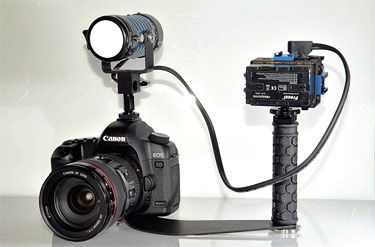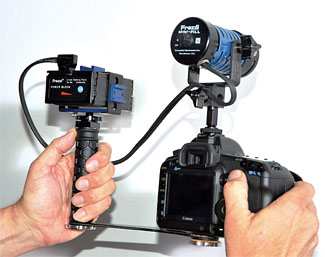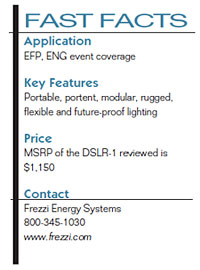Frezzi DSLR-1 Light and Support

The Frezzi DSLR-1 dimmer light kit and support
Even though they are generally more light-sensitive than most video cameras, DSLRs do require portable lighting, whether it's simply for highlighting a face, head and shoulders, or for lighting a small room. While most of the cameras have shoes for mounting small camera lights, they have a unique problem in terms of power supply. The newest lithium ion camera batteries can power DSLRs for many hours, but don't have the extra capacity to handle a camera light.
One solution has been panels of low wattage LEDs powered by AA batteries. Another, pioneered by Frezzi Energy Systems, is to create a mobile power supply compact enough to mount on DSLRs, and with enough capacity to power their smallest camera light—the Mini-Fill—for a full working day.
FEATURES
Frezzi calls the system the "Power Block," perhaps due to the fact that it resembles a small building block. The size is a mere 3.5 x 3.2 x 1.6-inches, and it easily mounts on a camera's hot shoe, or atop the handgrip of a stabilizer arm packaged with Frezzi's DSLR light package. The unit weighs in at 16 ounces and is just heavy enough to counterbalance a DSLR attached to the stabilizer bar. The 14 Volt Power Block outputs 65 Wh, which can power the Mini-Fill with an 8 Watt LED for a full day of shooting. Conversely, you'll get barely 2 hours with the 35 Watt tungsten lamp (also included), running at full capacity. However, you can double that by dimming down the light by approximately 50 percent.
The Mini-Fill lighting instrument is a thick blue barrel with large cooling slits on top. At only 12 ounces and measuring four-inches in length and with a two-inch diameter, the Mini-Fill is perfectly sized for a DSLR. Optional extras include mini-barndoors and filter holder, a softbox, and a dichroic filter and bracket.
Frezzi has packaged the Mini-Fill and Power Block and a charger into three different DSLR lighting packages. Each includes a pair of bulbs: 35 Watt tungsten and 8 Watt LED.

The new Frezzi DSLR lighting device in use The first two DSLR packages feature a stabilizer arm with a rubberized handgrip which fastens to the base of the camera creating a DSLR support rig. The DSLR-1 package has one Power Block and a single channel fast charger, while the DSLR-2 package includes two Power Blocks and a dual-channel charger. Both include a battery mount holder and a shoe mount.
The DSLR-3 package has a beefier mounting rig—the Frezzi Stable Cam—and includes a dual-handled grip and a 100-Watt Power Block, along with a matching fast charger. StableCam is a shoulder-style rig that mounts the battery behind the user's shoulder on the "tail end" of the shoulder brace in order to provide proper balance. It also offers more options for positioning the camera vertically and horizontally on the rig.
IN USE
For my evaluation, I received the DSLR-1 package containing a Mini-Fill light, tungsten and LED lamps, a 14-Volt/65-Wh Power Block with meter, a single-channel quick charger, battery mount holder, hand grip/ DSLR stabilizer, bar and a shoe mount. The package also contained barn doors and a diffuser filter.
I got off to a fast start and was impressed with how smoothly the Power Block slid into the battery mounting holder with its three shoe mounts (one per side), yet how secure it was, once in. Anyone experienced with mobile lighting gear could readily hook up and mount the Mini-Fill light and Power Block together. Deploying them separately aboard the camera and adjustable the stabilizer arm was more involved though, as there were multiple options.
I tried several, and each had its pros and cons; however, this approach was better than trying to operate with the light and battery piled atop the camera without a stabilizer arm.
The stabilizer arm can also pivot through 360 degrees, which changes the Mini-Fill from a frontal fill to a side light. The beam can be tilted through a 90-degree arc and also pan more than 180 degrees. There's also the option to dim the light from either the tungsten or LED bulbs by up to 95 percent. Glare may be softened with a diffuser or other soft filter with the (optional) barndoor set.
I really loved how easy it was to keep the DSLR steady with the stabilizer arm during interviews, and in shooting song and other live acts that normally would require a tripod. Although this arm can pivot through a 360-degree arc, I found that the most comfortable and functional position was straight out from the camera body at 90 degrees to the lens. This provided a solid grip, and counterbalanced my right hand's grip on the camera body.
I was also impressed with the camera-to-subject distance at which I could adequately light most residential room scenes with barely enough existing light by which to read. Sometimes I used the diffusion filter if there was no other way to reduce glare. In scenes with substantial ambient light, the tungsten lamp generally blended well with other tungsten sources, as well as with compact fluorescents, while the LED generally did better in daylight illumination. Even at low existing light levels as encountered in basement and heavily curtained rooms I was repeatedly impressed by the vivid color captured by the DSLR.
In trial after trial, I got more lighting punch than anticipated. However this may be due to conditioning on my part by experiences with other self-powered small camera lights.

An unexpected extra feature from the DSLR-1 package was the stability and mobility boost that it delivered. Static shots that ordinarily became unpleasant after a minute or so remained comfortable when I used the stabilizer arm. I was impressed with how smoothly I could do walking and tracking shots (at least when framed wide), with the arm. The only hiccup was a bit of slop in the light head unless I snugged things extra tight. Otherwise all components in the package preformed as advertised, and often better.
I was also impressed with how long I could run the light with the Power Block; not only the LED, but also with the tungsten lamp. This was especially so when I dimmed down to 25 or 50 percent, which the Mini-Fill's strong output allowed me to do. Also, I always knew how much charge was left in the tank, as there are four LED indicators, with each corresponding to 25 percent of the unit's capacity. Whenever I was down to the two-indicator mark, I simply recharged as soon as possible. Charging required only three hours or so. To me, this was a real blessing after using a conventional camera light that required three or more NP1 batteries to make it through a full day of shooting.
Another big plus with this Frezzi modular approach to camera lighting is being able to upgrade the package without having to trade up. As improved bulbs become available, the capacity of the Mini-Fill can be enhanced for the cost of the new bulb, rather than having to buy an entirely new light or complete system. My gear closet is piled with non-upgradable gear, which offers mute testimony to the reason that I'm really sold on the Frezzi future-proof approach to lighting for DSLRs and small camcorders.
SUMMARY
Frezzi's DSLR lighting packages offer a lot of "beam for the buck" in a fairly simple, modular camera light kit that's straightforward and easy to use. Even the basic DSLR-1 package offers myriad lighting options. The ability to achieve 5000 and 3200 degree K color temperatures by changing bulbs instead of employing of a conversion filter means that you can get plenty of illumination at both color temperatures. This allows shooters to take full advantage of existing light and to further extend the Power Pack's field runtime. All of the components are well designed and built to endure the rough and tumble of pro use.
Carl Mrozek operates Eagle Eye Media, based in Buffalo, N.Y., which specializes in wildlife and outdoor subjects. His work regularly appears on the Discovery Channel, The Weather Channel, CBS, PBS and other networks. Contact him ateagleye11@gmail.com.
The professional video industry's #1 source for news, trends and product and tech information. Sign up below.
